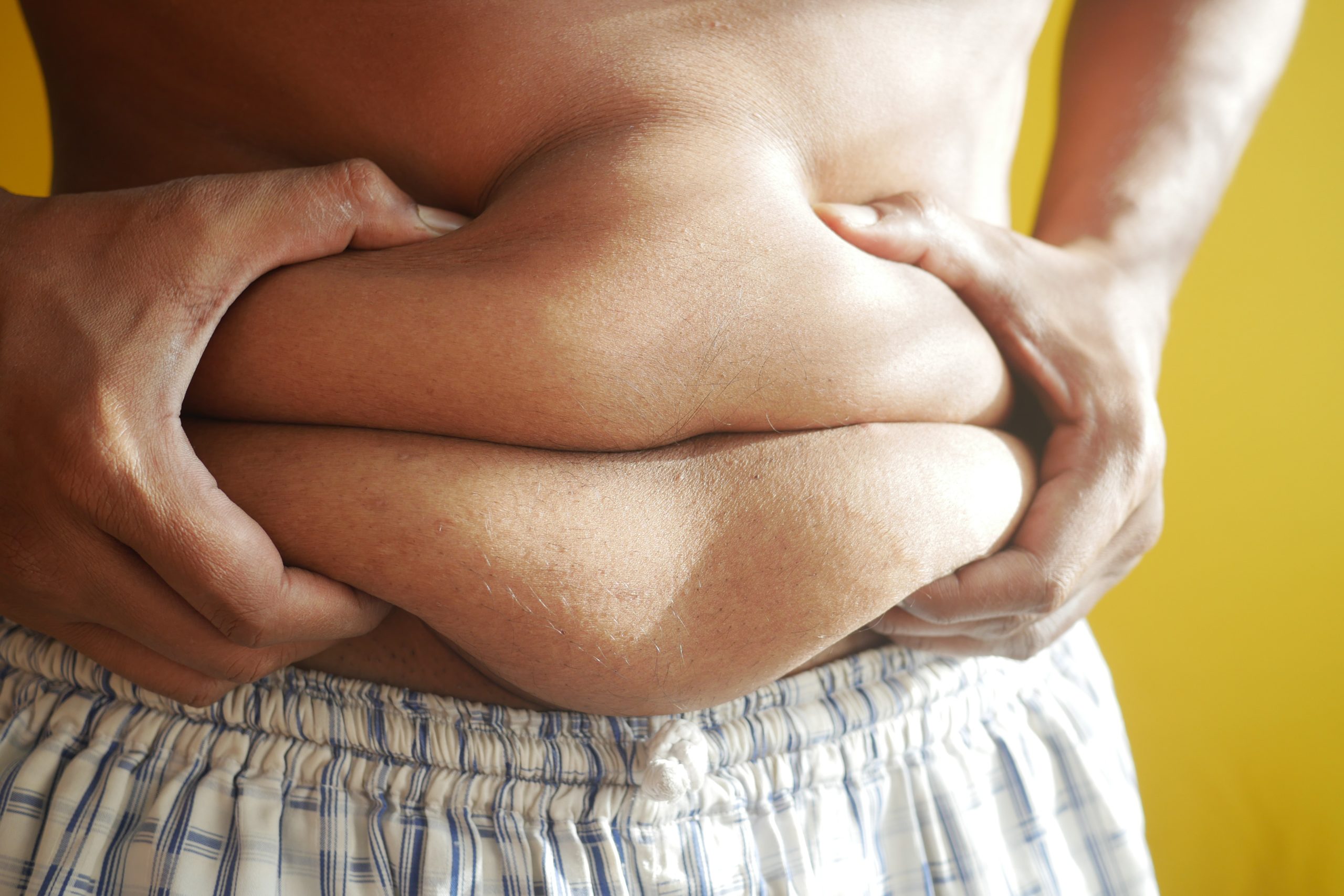The middle age spread is a term used to describe the increase in fat mass as we age, typically as we approach and pass our 40s. It is a very common problem, with nearly 70% of UK men, predominantly aged 40 and over, now classified as being overweight.
After the age of 40, studies have shown that we add an extra 0.7kg of weight every year. By the time you hit 60–70 years old, you can have up to 30 per cent more body fat than when you were 20.
For many, the pain of this weight gain is aesthetic. We may not like what we see in the mirror, not like the feeling of our clothes straining against the belly, and may even be unable to look down and see our … toes! This can negatively affect confidence, self-esteem, and mood.
Health Risks Associated with Middle Age Visceral Fat

Unfortunately, this extra body fat, especially when accumulated around the middle, can also do more than just emotional damage. It also affects both our physical and cognitive capabilities.
Studies have found that increased fat mass, in particular the fat around our organs (visceral fat), is associated with reduced cardiorespiratory fitness, agility, speed, and strength. It has also been found that cognitive functions such as memory, processing speed, and focus are impaired with increased body fat. These are changes that we normally associate with ageing, which has been accelerated by increased fat mass.
The negative effects don’t stop there. Increased weight around key areas of the body is also known to be a key factor in the development of many chronic diseases such as heart disease, strokes, type 2 diabetes, dementia, cancer, and elevated cholesterol levels. For example, a study found that obesity increased the risk of developing coronary heart disease by 64% in men.
In another study, it was found that for each 5-unit increase in BMI (a crude measure of body fat), there was a 16% increased risk of mortality from all causes, a 21% increased risk of mortality from cardiovascular disease, and a 7% increased risk of mortality from cancer.
Being able to lose fat mass, even just by 5%, through targeted diet and exercise, would allow you to benefit in many ways. Better physique, more confidence, better performance both physically and cognitively, and improved health. Essentially, it could help you live longer, stronger!
The trouble is that the middle-age spread isn’t easy to fix, hence why nearly 70% of UK adults are overweight, and why the weight loss industry was worth over $245.5 billion in 2020.
But why is it harder to maintain a healthy weight in our middle-aged years than it would be in our 20s?
Understanding Metabolism and Middle Age Belly Fat
Often, the blame is laid on our metabolism slowing down as we age. However, a recent study found that our metabolism remains pretty stable from our 20s and 30s until around 60 years of age when adjusted for fat-free mass. What the study highlighted was that total energy expenditure was strongly related to fat-free mass, i.e. muscle.
Lean muscle burns about 10 calories per pound (22 calories per kg) per day at rest, emphasizing the importance of maintaining lean muscle mass to avoid weight gain. Fat tissue burns about 2 calories per pound (4.4 calories per kg) per day. As we age, we lose muscle mass, a process called sarcopenia. This means that we need fewer calories to maintain our low-muscle, high-fat, body composition.
Unfortunately, our eating habits do not usually change, and so the end result is more calories in than calories out, resulting in a gain of fat mass.
Decreased Physical Activity and Its Role in Middle Age Weight Gain

As we go through life, we take on personal and professional obligations and responsibilities that demand our time and energy. When we were younger, we had the time to pursue hobbies and sports, go to the gym, and go for runs. Having kids, businesses, employees, meetings, elderly parents, and other demands limit our ability to have planned exercise time. Less exercise means fewer opportunities to burn calories, leading to more energy stored as fat.
On top of this, as we get older, we tend to spend more time being sedentary than we did when we were younger. This results in fewer calories burned and more energy stored.
Again, having less muscle mass compounds this. Having more muscle not only increases your resting metabolic rate but also increases the energy expended during physical activity. There is also more post-exercise energy expended for repairing the muscle tissue. Therefore, having less muscle mass results in fewer calories burned and, yes, you guessed it, more energy stored as fat.
Hormonal Changes Contributing to Middle Age Spread

As we continue to age, other factors start to come into play – our hormones.
There are many hormones that change with age, but probably the most well-known for men is testosterone. This is a sex hormone, and it helps develop the male secondary sexual characteristics such as increased muscle mass, body hair, and a deeper voice.
After the age of 40, the levels of testosterone in our bodies drop by 1% every year. Low testosterone levels are associated with decreased muscle mass and increased fat accumulation (as well as decreased libido, fatigue, and depression).
We also have lower levels of oestrogen as we age because it is made from testosterone. Oestrogen is known as the female sex hormone, but it is also present in smaller amounts in men. It has many roles, but one of them is dictating body fat distribution.
When levels of this hormone drop, it causes an increase in the fat around the middle. This is called visceral fat, a type of fat that is stored within the abdominal cavity and packed around the internal organs. It is considered to be the most harmful type of fat as it is metabolically active, producing hormones and inflammation that are linked with the development of chronic diseases.
Another important hormone that declines with age and contributes to the middle-age spread is the growth hormone.
This is a hormone produced by a small gland in the brain. It helps to regulate metabolism, muscle growth, and bone density. By the time we are 60, we produce only 25% of the amount of growth hormone we did when we were 20. This drop causes decreased muscle mass and increased fat mass.
How Appetite Hormones Influence Middle Age Fat Accumulation
Two other hormones, leptin and ghrelin, also play a role in the spread of middle age as we age.
Leptin is a hormone produced by our fat cells, and it regulates our appetite and energy expenditure. It essentially tells us when we have taken in enough energy and suppresses our appetite. This hormone decreases as we get older, resulting in increased appetite and reduced energy expenditure. More calories in, fewer calories out, means more energy stored as fat.
Ghrelin is produced by the stomach, and it signals hunger to the brain, causing an increase in appetite and energy storage. This hormone increases as we age, resulting in more calories consumed and increased fat mass.
Cortisol and Its Impact on Middle Age Weight Gain
Chronic stress is a common problem, especially when trying to ensure both balance and success in our personal and professional lives.
In response to stress, the body produces cortisol, which helps prepare the body to protect itself. Unfortunately, when this response stays switched on in situations of chronic stress, this causes an increase in appetite, increased fat storage, and reduced fat breakdown.
An added negative effect of increased cortisol is that it interferes with the production of testosterone, resulting in less being present in the body.
The Role of Sleep in Accelerating Middle Age Health Risks

Getting quality sleep has many positive effects on the body, including the regulation of the hormones mentioned above.
The effect of poor sleep is to speed up the ageing process in our bodies. What I mean by this is that it further lowers testosterone, oestrogen, and leptin while increasing cortisol, ghrelin, and insulin. The end result is an acceleration of muscle mass loss and increased fat mass.
Effective Strategies to Reverse Middle Age Weight Gain
In the last post, I introduced the foundations of the framework I use to help my patients restore their health and optimise their performance: genetics, environment, and behaviour. Through detailed assessment, a personalised, precise and proactive plan can be made to combat the middle-age spread.
However, in my experience, if you try to make all the changes identified in one go, then you could be setting yourself up for frustration and failure. This is why many often yo-yo with their weight, they try to do too much.
Instead, you should take it step-by-step, focusing on those actions that offer the greatest ROI. Try the following 3 steps to combat the middle age spread, making sure to establish each step before moving on to the next. Life isn’t a sprint, so don’t rush the process.
Step 1: Improve Your Sleep to Reduce Waistline
Get 7–9 hours of quality sleep consistently. This is the most important step because we know that lack of sleep creates an unfavourable hormonal environment that impairs your ability to make good food choices, lose fat, and gain muscle. Once this is established, the next step will be a lot easier.
Step 2: Enhance Your Diet to Combat Belly Fat
Use an online calculator to work out what your daily calorie intake should be. It is best to determine your body fat percentage and use calculators that use this value to determine your calories.
When you have that number, reduce it by 10–20% to create a moderate calorie deficit. You can adjust this according to how your weight changes over time.
There are so many diets out there to choose from that it can be overwhelming. My advice is to simply ensure that you choose unprocessed, whole foods to eat, and focus on getting enough protein. Aim for about 1.2–1.8 g of protein per kg of body weight.
Step 3: Boost Your Exercise Routine to Fight Middle Age Weight Gain
Once you have established a consistent sleep routine and optimised your nutrition, you can incorporate aerobic exercises as part of your routine.
The primary aim is to build muscle to combat the loss that comes with age. For most, the best starting routine is to incorporate resistance training exercises to build muscle with two to three full-body weight training workouts every week. If you have little experience with resistance training, then it is essential that you get advice on how to choose the exercises, rep ranges, and sets. Feel free to contact me if you need any help with this.
Breaking the Myth of Inevitable Middle Age Spread
Understanding what really causes the middle age spread reveals that it is not an inevitable part of the ageing process.
By incorporating good sleep habits, following a calorie-controlled diet that is high in protein, and incorporating weight training into your fitness routine, you can combat the tendency to gain weight as you age.
These lifestyle changes have been shown to help build and maintain muscle mass, boost metabolism, and promote overall health and well-being, including better blood pressure and cholesterol levels.
If you make these changes early on, you can enjoy a healthier and more active lifestyle well into your later years. Remember, it’s never too late to take control of your health and make positive changes for your future.




